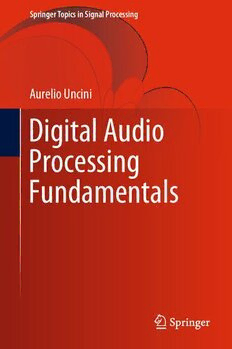Table Of ContentSpringer Topics in Signal Processing
Aurelio Uncini
Digital Audio
Processing
Fundamentals
Springer Topics in Signal Processing
Volume 21
SeriesEditors
JacobBenesty,INRS-EMT,UniversityofQuebec,Montreal,QC,Canada
WalterKellermann,Erlangen-Nürnberg,Friedrich-Alexander-Universität,
Erlangen,Germany
The aim of the Springer Topics in Signal Processing series is to publish very high
quality theoretical works, new developments, and advances in the field of signal
processingresearch.Importantapplicationsofsignalprocessingarecoveredaswell.
Withinthescopeoftheseriesaretextbooks,monographs,andeditedbooks.
Topicsincludebutarenotlimitedto:
*Audio&AcousticSignalProcessing
*BiomedicalSignal&ImageProcessing
*Design&ImplementationofSignalProcessing
*GraphTheory&SignalProcessing
*IndustrialSignalProcessing
*MachineLearningforSignalProcessing
*MultimediaSignalProcessing
*QuantumSignalProcessing
*RemoteSensing&SignalProcessing
*SensorArray&MultichannelSignalProcessing
*SignalProcessingforBigData
*SignalProcessingforCommunication&Networking
*SignalProcessingforCyberSecurity
*SignalProcessingforEducation
*SignalProcessingforSmartSystems
*SignalProcessingImplementation
*SignalProcessingTheory&Methods
*Spokenlanguageprocessing
**Indexing:ThebooksofthisseriesareindexedinScopusandzbMATH**
Aurelio Uncini
Digital Audio Processing
Fundamentals
AurelioUncini
DIET
SapienzaUniversityofRome
Rome,Italy
ISSN 1866-2609 ISSN 1866-2617 (electronic)
SpringerTopicsinSignalProcessing
ISBN 978-3-031-14227-7 ISBN 978-3-031-14228-4 (eBook)
https://doi.org/10.1007/978-3-031-14228-4
©TheEditor(s)(ifapplicable)andTheAuthor(s),underexclusivelicensetoSpringerNature
SwitzerlandAG2022
Thisworkissubjecttocopyright.AllrightsaresolelyandexclusivelylicensedbythePublisher,whether
thewholeorpartofthematerialisconcerned,specificallytherightsoftranslation,reprinting,reuse
ofillustrations,recitation,broadcasting,reproductiononmicrofilmsorinanyotherphysicalway,and
transmissionorinformationstorageandretrieval,electronicadaptation,computersoftware,orbysimilar
ordissimilarmethodologynowknownorhereafterdeveloped.
Theuseofgeneraldescriptivenames,registerednames,trademarks,servicemarks,etc.inthispublication
doesnotimply,evenintheabsenceofaspecificstatement,thatsuchnamesareexemptfromtherelevant
protectivelawsandregulationsandthereforefreeforgeneraluse.
Thepublisher,theauthors,andtheeditorsaresafetoassumethattheadviceandinformationinthisbook
arebelievedtobetrueandaccurateatthedateofpublication.Neitherthepublishernortheauthorsor
theeditorsgiveawarranty,expressedorimplied,withrespecttothematerialcontainedhereinorforany
errorsoromissionsthatmayhavebeenmade.Thepublisherremainsneutralwithregardtojurisdictional
claimsinpublishedmapsandinstitutionalaffiliations.
ThisSpringerimprintispublishedbytheregisteredcompanySpringerNatureSwitzerlandAG
Theregisteredcompanyaddressis:Gewerbestrasse11,6330Cham,Switzerland
Preface
The recent evolution in the field of information and communication technologies
(ICT) has made possible many innovative ways in the use of voice, music, audio-
visual, multimedia and, in general, multimodal information. In the case of music,
forexample,theimpactoftoday’stechnologiesiscomparabletowhatthepresshas
had on literary work: in the world of the arts, music is, in fact, among those that
mostintimatelycomparesitselfwiththemeansthatscienceandthetechniquemake
available.
Inthiscontext,deeplylinkedtotheworldofmultimediaandmultimodalcommu-
nication,inthevolume“DigitalAudioProcessingFundamentals,”weintendtofocus
onsomeaspectsthatcharacterizethebinomialsaudio-technologyandengineering
music.Themethodsofdigitalmanipulationofsounds,thestudyofartificialspaces
andaudioeffectsformusicaluse,themethodsandtechniquesfordigitalsynthesis
ofthemusicalsignal,signalcompression,soundspatialization,virtualaudioarejust
someconcretetechnicalexamples.
Inmore recenttimes,thecollaboration between scientistsfromICT,communi-
cation sciences, modeling and acoustic physics has led to the emergence of new
disciplines such as the science of auditory communication, whose salient aspects
range from the computational analysis of the auditory scene, the study of multi-
modalhuman–computerinterface,augmentedrealitysystems,audioforvirtualenvi-
ronmentsandsoon.Themedium,infact,doesnotsimplycoincidewiththetech-
nicaltransmission–receptionapparatus,butconsistsofacomplexsystemwhich,in
additiontothetechnologicalapparatus,impliestherelationshipbetweenthisappa-
ratusandtheperceptualandcognitiveprocessesofman;inthiscontext,thesound
information,vocal,non-vocal,musical,etc.,takesonaroleofprimaryimportance.
Theinterestindigitalaudiosignalprocessinganditsspin-offsinvariousmanu-
facturingsectors,aswellasthecross-cuttingskillsneeded,areverybroad.Thebasic
disciplinestoaddressnotsuperficiallysuchtopicsinarehardlycoveredinthecore
coursesofasingledegreeprogram.
This text, born from twenty-five years of teaching experience of the author in
thecourseofDigitalAudioSignalProcessing,heldattheUniversityofRome“La
Sapienza”—Italy,forstudentsofdegreecoursesinEngineering,isatransversaland
v
vi Preface
interdisciplinarywork,mainlydedicatedtothevariousspecializationsofcomputer
science, communications but also others such as electronics, mechanics and other
courseswherethereareofteninterestsindigitalaudiosignalprocessing.
Theworkprovidesanoverviewanddidacticallyconsistentoftheproblemsrelated
to the processing of the audio signal in its various aspects, from the numerical
modeling of vibrating systems to the circuits and algorithms for manipulation and
generationofsoundsignals.
The topics covered, while requiring strong interdisciplinary skills, acoustics,
mechanical, electrical and computer science, are developed in a self-contained
fashion,usingamathematicsthatshouldbeknownfrompreviouscoursesinthefirst
two years of science faculties. The two volumes, while complementary in subject
matter,areautonomousandself-containedworks
ThefirstvolumeDigitalAudioProcessingFundamentalsisorganizedconceptu-
allyintothreeparts.
The first introductory part consists of two chapters, where the fundamental
concepts of vibration mechanics, and the various modes of possible generation of
soundwavesarereported.Linearandnonlinearvibrationmodelsincontinuousand
discretesystemsareintroduced.Thecircuitanalogiesofmobilityandimpedanceare
introduced, and the concepts of sound waves in air and the electro-acoustic trans-
ducersarebrieflyrecalled.Alsointhefirstpart,discrete-timecircuitmodelsandbasic
methodologiesforone-andmulti-dimensionalnumericalfilteringareintroduced.
The central part deals specifically with audio signal processing methodologies.
Filtersforaudio,multiratesystemsandwavelettransformsareintroduced,so-called
specialtransferfunctionsforaudioapplicationsarediscussed,andcircuitmodeling
methodsforphysicalmodelingofcomplexacousticphenomenawithbothlumped
anddistributedparametersarediscussed.
Inthethirdpart,theso-calledaudioeffectsareintroduced,suchasreverberators,
dynamic range control of the audio signal, effects based on time–frequency trans-
formations.Inthelasttwochapters,abstractsoundsynthesismethodsandphysical
modelingareintroducedanddiscussed.
Rome,Italy AurelioUncini
July2022
Acknowledgments
Many friends and colleagues have contributed to the creation of this book by
providing useful suggestions, rereading drafts or endorsing my ruminations on
the subject. I would like to thank my colleagues Stefania Colonnese, Danilo
Comminiello, Massimo Panella, Raffaele Parisi, Simone Scardapane and Michele
ScarpinitioftheDepartmentofInformationEngineering,ElectronicsandTelecom-
municationsoftheUniversitàdegliStudidiRoma—“LaSapienza,”Italy;Giovanni
Costantini of the Università degli Studi di Roma—“Tor Vergata,” Italy; Stefania
Cecchi,oftheUniversitàPolitecnicadelleMarche,Ancona,Italy.
I would also like to thank all the students who provided me with very useful
verificationsforthecorrectexpositionofthetopicsinthetext.
vii
Contents
1 VibratingSystems .............................................. 1
1.1 Introduction .............................................. 1
1.2 VibratingSystemsinOneDimension ......................... 1
1.2.1 SimpleHarmonicMotion ........................... 2
1.2.2 DampedHarmonicOscillator ........................ 5
1.2.3 PhasorRelatedtoQuantitiesx,vanda ............... 9
1.3 ForcedOscillations ........................................ 10
1.3.1 Transfer Function, Frequency, and Impulse
Responses ........................................ 11
1.3.2 TransientandSteady-StateResponse ................. 15
1.3.3 SinusoidalResponse,MobilityandImpedance ......... 16
1.3.4 CalculationofCompleteResponse ................... 18
1.3.5 GenericHelmholtzOscillatingSystems ............... 18
1.4 ElectricalCircuitAnalogies ................................. 21
1.4.1 KirchhoffLaws .................................... 22
1.4.2 AnalogyofMobility ............................... 23
1.4.3 AnalogyofImpedance .............................. 26
1.5 NonlinearOscillatingSystems .............................. 27
1.5.1 GeneralNotationandStateSpaceRepresentation ....... 27
1.5.2 2nd-OrderNonlinearOscillatingSystems ............. 31
1.5.3 UndampedPendulum ............................... 32
1.5.4 VanDerPolandRayleighOscillators ................. 35
1.5.5 DuffingNonlinearOscillator ........................ 38
1.5.6 MusicalInstrumentasaSelf-sustainedOscillator ....... 42
1.5.7 MultimodalNonlinearOscillator ..................... 47
1.6 ContinuousVibratingSystems .............................. 47
1.6.1 IdealStringWaveEquation .......................... 48
1.6.2 SolutionoftheStringWaveEquation ................. 50
1.6.3 StringsVibrationandMusicalScales ................. 60
1.6.4 LossyandDispersiveString ......................... 65
1.6.5 TheVibrationofMembranes ........................ 71
ix

